Bass at the Drop of a ShotBy Rich Zaleski | ||
It's new!Well, maybe it's not so new. Live bait fishermen have been using rigs with the hook(s) tied above the weight for eons, and that is the essence of drop shot (also known as under shot) rigging. OK, you say, but as a method for presenting soft plastic artificials, this is a hot, new technique from Japan. Well, yes and no.
Of course I never did anything with that rig that even remotely approaches the productivity and efficiency of the drop shot rig as we know it today. Eliminating the leader between the hook and the main line, along with the development of the self-cinching weight (eg, Bakudan) were major improvements and opened the door for specialized drop shot baits and the concept of using it to fish unweighted lures at depth. Wherever There are a lot of drop shot rig variations, but they all have one thing in common — the soft plastic lure rides above the weight. It's really not a light tackle thing or finesse thing. It's a weight thing. Plenty to take it down, none to interfere with the action of the lure. In drop shot fishing, the weight is an anchor. It takes your bait into position and it keeps it there, but is functionally inert in the actual presentation of the lure. Whether it's a little 3" Dart or an 8" worm, whether the weight you use to get it in place is 1/8 oz or 1 oz, whether the line is 6 pound test or 20, it's all basically the same deal -- the weight is sitting on bottom while you dance the worm around with the rod tip on a semi-slack line. So why dropshot?
Enter the dropshot rig. The weight takes the bait into position, but once the lure is in the potential fish zone, the weight is resting on bottom, out of play, and the lure itself is fished pretty much in a weightless fashion. Not only does the weight not affect the way the lure moves in the water, there's no weight between you and the hook to interfere with your sense of feel when a fish takes the lure. No doubt some will opine that a Carolina rig accomplishes much the same thing, but nothing could be further from the truth. In Carolina rig fishing, you have to pull the weight to move the bait. It's impossible to fish it in place. If you stop pulling for more than a few seconds, the bait is resting on bottom (unless using one of those high-floating, Cyberflex plastics) and there's no way to get it off bottom again without moving it a considerable distance. The Carolina rig is superior for covering water, but the drop shot rig really shines for triggering fish. Further, with the drop shot rig, the part of the line that is subject to abrasion from bottom debris is not between you and the lure -- or between you and the fish, once you've hooked one. This allows you to work in cover or across abrasive bottom substrate (eg, zebra mussel beds) with confidence that you're not likely to lose a fish to a badly nicked or frayed line. The "lure up" factor is also an advantage fishing mossy bottoms. In fact, one of the reasons I started playing around with that "inverted split shot rig" shown at the beginning of this article, is that some of my favorite lakes have "rock moss" (aka "skunk moss" or "black snotweed") carpeting the deeper hard bottom areas. If you're not in the snotweed, you're not likely to get bit. But a light jighead, or even a Texas rig gets mired down in the snot as soon as it settles, rendering the rest of the retrieve at best questionable, and at worst, useless. The drop shot rig virtually eliminates this concern. Of course it works as well in sand grass and other low growing vegetation. Disadvantages?In a word, twist. As in line twist. It comes with the technique. Using a fully swiveled weight can help, but much of the twist comes from the bait, not the weight, so you'll never eliminate all of it that way. I've tried putting a small swivel a couple feet above the hook. Caught fish rigged that way, too. But it makes tying the whole thing up into a project, and it really does interfere with my sense of feel. A swivel may not be much hardware between me and the hook, but it's infinitely more than no hardware between me and the hook. California drop shot guru Rich Tauber says that most of the twist occurs not while actually fishing the lure, but while reeling it back to the boat for your next cast. He recommends reeling the lure back to the boat very slowly and steadily following the working portion of the retrieve. Slow it up, and you cut that way down. Of course accepting that idea and developing the discipline to wind it in slowly when there are more casts to make and fish to tempt are two different things. I try, but in the end, I found the best approach for me is to take what measures I can to control the twist, but to live with what I get and then minimize it by clipping everything off and running the free line behind the boat as I idle in to the ramp every couple trips. Rigging a drop shot.You start by tying the hook on with a palomar knot, leaving a long tag end -- Typically, 10" to 36", but longer in specific situations which call for fishing the bait higher off the bottom. I have caught fish much farther above the sinker, but the configuration I start with unless I actually see fish suspended higher, puts the bait 12" to 14" above the bottom. Step-by-step photo illustrations are linked below. For the sake of visibility, I used a heavy tackle drop shot (ie, bubba shot) rig in the photos. The steps are the same with more traditional dropshot tackle, it's just easier to see with the big stuff. OK, here's how to tie it up.
Speaking of the drop shot sinker...Time was, I used a great big old split shot. To often though, it would slide off the line on the cast or with very little pressure on a hang. And since it's flat out impossible to crimp on a split shot dead center, it would twist the line big time. Even worse when I got into more than 15 feet or so of water and doubled up the split shot. Tying an overhand knot in the end of the line would keep the shot from sliding off. But when I got it wedged, it somehow ended up being too hard to slide off, and I'd break the whole thing off, or the line would break right at the knot, leaving me just the hook and no dropper. Either way, it meant retying the whole thing. Then I went to a slip sinker above a smaller split shot, with a loop knot tied in the end of the line. Look closely at the first photo in this article and you'll see this weight setup. This twisted a bit less, and the loop knot gave me something to hook to the reel handle when I put the rig down to move. But I still had the re-rig problem. And to tell you the truth, the more knots I have to tie and pieces I need to deal with, the less likely I am to re-rig it when it breaks, so too often, I would end up fishing something else after the first serious hang-up. It wasn't until Kota Kiryama introduced me to the Bakudan sinker that I found the answer. The swivel and self cinching line attachment make all the difference in the world. Since Bakudan was taken over by Lunker City, they replaced all the old molds and the quality and consistency of the product has gone way up. Naturally, I tried some other variations of the same weight concept along the way. Some had the clip and no swivel. Why bother? Cheaper "house brand" models from BPS only used half the swivel, and the cinch clip was just different enough that it didn't grip the line as surely and easily. As far as I can tell, more expensive, tungsten weights provide no advantage unless you like paying more. I know they say you can feel the bottom better with the hard tungsten, but I haven't been able to feel anything important with it. And when I see weights advertised as drop shot weights that have no swivel or a line tie instead of the cinch on deal, I know that the company is just trying to capitalize on the trend and has absolutely no clue about drop shot fishing. For what it's worth, I prefer the cylindrical weights over the original balls. I just seem to hang up less with them. Some anglers claim they can feel the bottom better with the round weights, but I see absolutely no difference in that regard. For some reason, some anglers seem to feel a need to replace the drop shot weight with a jig. As far as I'm concerned, all that does is hang up more. Plus, when you get bit, you're never sure whether the bite is on the DS bait or the jig, so you have to set the hook like it was a jig bite, which is all wrong for the rather tiny drop shot hook. And I don't know about you, but I'm not real thrilled with the idea of an extra knot on the line between me and the fish when I'm fishing a jig. If you want to fish a jig, fish a jig. If you want to drop shot, use a drop shot weight at the end of your line. If you really want an extra hook, just tie two hooks to the main line, 6" or 8" apart. Balancing the tackle to the task.I break drop shotting into two categories. You might call them finesse drop shotting and power drop shotting. For the purposes of article, I'll confine myself to the former. But keep in mind that once you've got the basics of the technique down, bumping up the tackle and using a heavy drop shot weight to present larger baits in heavy cover can offer some tremendous advantages.
A lightweight spinning reel that handles 4 and 6 pound test fluoro smoothly and easily is a necessity, but there's no need to break the bank to get one. I was satisfied for quite a while with the performance of the moderately priced Pfleuger President 6720 spinning reel for drop shotting. The only flaw in its design as far as I was concerned, was a tendency for the line to hang up on the back side of the line roller arm. It seemed a minor annoyance until I noticed that my line was getting frayed and knicked on first use, and discovered that the line had actually worn a nasty groove in that piece. I've since switched over to a Daiwa Tierra 2000 for my drop shot rods and absolutely love feel and performance of the reel. It's a bit on the pricey side for my preferences, but at least it's not wearing a groove in itself every time I use it. Since I backreel and don't rely on the drag at all, it's of no consequence to me, but for those who depend on the drag, make sure to use a reel with a smooth one, like the abovementioned Daiwa model. The above described rig will work with all of the small baits that we think of as typical drop shot baits (more on which later). You're not going to be setting a big, heavy hook with this gear. I can't remember the last time I really needed to Texas rig a drop shot bait, and I pretty much nose hook exclusively these days when drop shot fishing. Depending on the size of the bait, I use a #1 or #2 Gamakatsu split shot/drop shot hook to do this. The baitsJust about any small, soft plastic lure will work for drop shot fishing. I'm always experimenting to find a better one, and after several years of trial and error, I've narrowed my must have assortment down to pretty much the meager selection below.
You probably notice a theme in my preferred color schemes. Generally speaking, drop shotting is a finesse tactic designed to tempt neutral/negative or heavily pressured fish. Toward that end, low impact colors -- those that don't stand out from their surroundings and aren't likely to alarm or intimidate the fish -- are the most logical choices. For me, that means that if it's not some variation on translucent brown and/or green, it's probably a really natural looking baitfish imitation. When and where to drop shot.Seasonally, there's no time of the year that one dropshot variation or another won't work to some extent. But there are times and places when it's the odds on choice. In northern, natural lakes, where the deep edge of the weed growth is typically the important pivot point in bass location, any time other than when I'm fishing right in the weeds is liable to be drop shot time. I will rarely fail to at least try it along the deep weed edge, at the base of the drop-offs and on extended points that reach out beyond the deepest growing vegetation. Cold I'll drop shot pretty much anywhere I can work the weight along the bottom without being completely mired down in the weeds. Because the business part of the line -- the connection between you and the hook (and ultimately the fish) is above the fray so to speak, it allows the use of light line and finesse baits in and around some pretty nasty places. If I'm not so deep into cover that the 4 to 8 pound test line I use for drop shotting isn't hopelessly outclassed, I have no hesitancy to throw it into really snaggy stuff. I'll fish it as shallow as 3 or 4 feet, and as deep as -- well as deep as I can find fish. Depends on the season and the waterbody. And for what it's worth, it takes a lot more to hopelessly outclass 6 pound test line than you probably imagine. I guess that if you exclude heavy tackle bubba shotting, my drop shot efforts fall into 4 categories:
Once you've got all the pieces in place, the biggest things between most fishermen and drop shot success are feel and hook setting. I really believe that there's an over-reliance on line watching prevalent in today's bass fishing world, and that tendency has contributed to an overall decline in the ability of bass anglers to fish by braille. And fishing by braille will get you a lot farther in drop shotting than line watching will. Remember, most hits are going to come on a semi-slack to slack line. No matter how sensitive your rod is, you'll feel several magnitudes more through a finger in contact with the line than you will through the rod when fishing slack. When I'm jiggling the bait on a slack line, and as I lift the rod tip to "weigh the bait" before lifting the sinker to put it in a new spot for more jiggling, I keep the line hooked with the extended index finger of my rod (in my case, left) hand. The key is what you do after you sense that tingle of life in the slack line hooked over your index finger. When the fish are on the aggressive side, they might just grab the bait and swim off with it. Those are easy fish, and days when they act like that are easy days. But there's also what I call maximum difficulty drop shot fish, and its those fish that separate the really good drop shot fishermen from the pack. These are the fish that make me rely on balance fishing. I'll extend that index finger a bit farther and open my grip so the light rod comes to rest on the fingertip, with the line still hooked there, too. Experience has taught me where the rod will balance, and that's where I let the rod come down on my finger. The light, soft action rod just rests there as I study the rod tip and sense, rather than actually feel, the presence of a fish. Sometimes, you'll swear you can sense the fish munching the bait. Other times, you'll feel little or nothing until the fish starts to move with the lure and the rod tip swings gently downward. The point is, sooner or later, you're either going to decide that the fish is not there, or decide that it is, and that it's got the lure in its mouth. When the latter happens, it's time to set the hook. Gently. This is the only technique in which I use anything resembling a gentle hook set. Then again, I've had some anglers in the boat with me tell me that my version of a gentle set is sharper and harder than many anglers' normal hook set motion. By gentle, I mean that I just lift my hand a foot or so while rotating my wrist to whip the rod tip smartly upward a couple feet, and start reeling. It's definitely a wimpy move in relation to the "powersnap" hookset I usually favor. But it's all you need or want with this technique. Then I let the long, limber rod do its job as I rely on reeling and backreeling to keep a steady bend in the rod, and let the pressure work the fish to the boat. I'm not sure there's much more I can tell you about drop shotting without overcomplicating the issue. It's not really difficult, it's just a matter diddling around with a little soft plastic bait, trying to fool a fish into mistaking it for an easy meal. But if you're in the mood for a few more tips, here's the link. | ||
| ||
 |
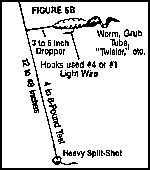 It's remarkably similar to the illustration at the right, from my article "Bass Fishing Tough? These Offbeat Rigs Can Save the Day" published in the November/December 1990 issue of Fishing Facts magazine. Prior to that article, I had described the same rig in both Fishing Facts and In-Fisherman on at least two occasions, as well as in Bassin' Magazine.
It's remarkably similar to the illustration at the right, from my article "Bass Fishing Tough? These Offbeat Rigs Can Save the Day" published in the November/December 1990 issue of Fishing Facts magazine. Prior to that article, I had described the same rig in both Fishing Facts and In-Fisherman on at least two occasions, as well as in Bassin' Magazine. its roots, the drop shot rig is more than the latest clear water/deep water fad. It's a valuable tool that can help anglers in all waters — clear and dingy, deep and shallow, moving and still — catch more fish, more often.
its roots, the drop shot rig is more than the latest clear water/deep water fad. It's a valuable tool that can help anglers in all waters — clear and dingy, deep and shallow, moving and still — catch more fish, more often.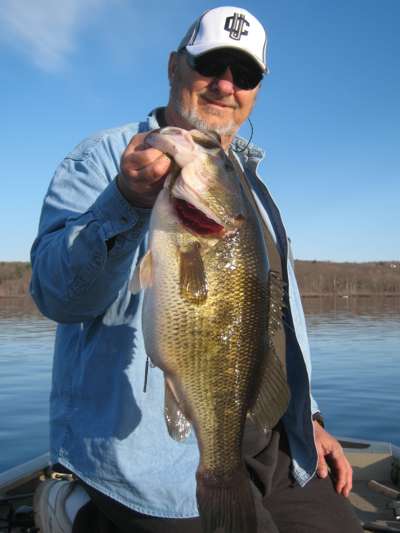 A soft plastic lure fished with no added weight drifts with a very fluid motion that has natural appeal to a predator. But it's tough to fish an unweighted soft plastic very deep, for obvious reasons.
A soft plastic lure fished with no added weight drifts with a very fluid motion that has natural appeal to a predator. But it's tough to fish an unweighted soft plastic very deep, for obvious reasons.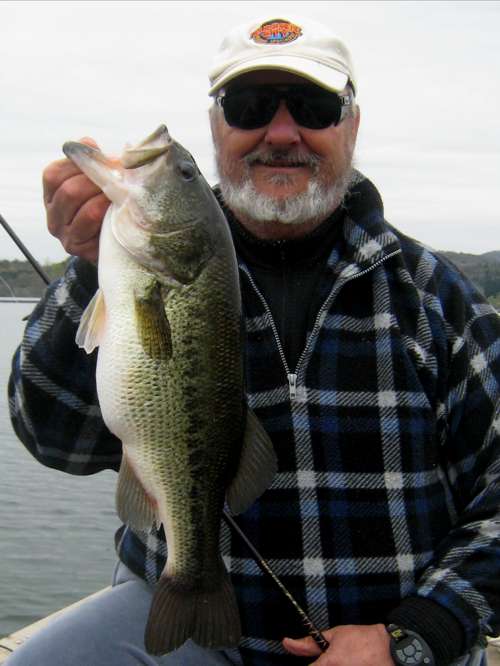 Drop shot fishing is usually thought of as a light line, "finesse" technique, and that is the way I usually fish it. Four or six pound test mono or fluorocarbon (I'm currently torn between Maxima Fluorocarbon and Seguar Invisix as to which is the best 6 pound test fluoro for drop shot fishing.). As far as the rod goes, any light to medium action spinning rod 6 to 7 feet long will do to get you started, but the closer you come to a 7 foot rod with a moderate taper built as light (in weight) as possible, the closer to the ideal drop shot rod you'll be using. Fuji "Concept" guide arrangement is ideal, as the reduced weight inherently increases sensitivity. The lighter and more sensitive the rod, the more fish you will feel and hook with this technique. I also prefer taping the reel to a straight cork "Tennessee handle" rather than using a reel seat. If you want the absolute best in drop shotting rods, contact Steve Huber at outdoorfrontiers.com and tell him you want one just like he builds for me.
Drop shot fishing is usually thought of as a light line, "finesse" technique, and that is the way I usually fish it. Four or six pound test mono or fluorocarbon (I'm currently torn between Maxima Fluorocarbon and Seguar Invisix as to which is the best 6 pound test fluoro for drop shot fishing.). As far as the rod goes, any light to medium action spinning rod 6 to 7 feet long will do to get you started, but the closer you come to a 7 foot rod with a moderate taper built as light (in weight) as possible, the closer to the ideal drop shot rod you'll be using. Fuji "Concept" guide arrangement is ideal, as the reduced weight inherently increases sensitivity. The lighter and more sensitive the rod, the more fish you will feel and hook with this technique. I also prefer taping the reel to a straight cork "Tennessee handle" rather than using a reel seat. If you want the absolute best in drop shotting rods, contact Steve Huber at outdoorfrontiers.com and tell him you want one just like he builds for me.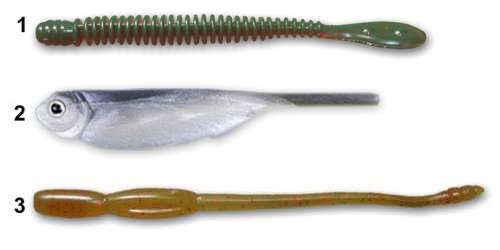
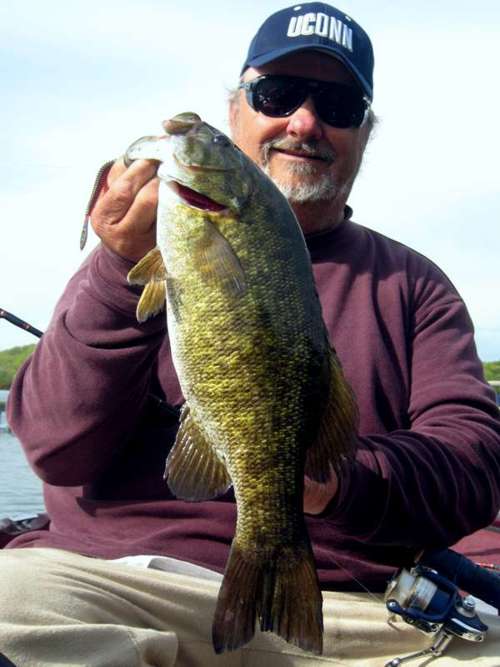 water time, too -- in just about any type of lake, river or reservoir. Because it makes it so easy to fish a bait in place, it's even an ideal bed fishing technique.
water time, too -- in just about any type of lake, river or reservoir. Because it makes it so easy to fish a bait in place, it's even an ideal bed fishing technique.